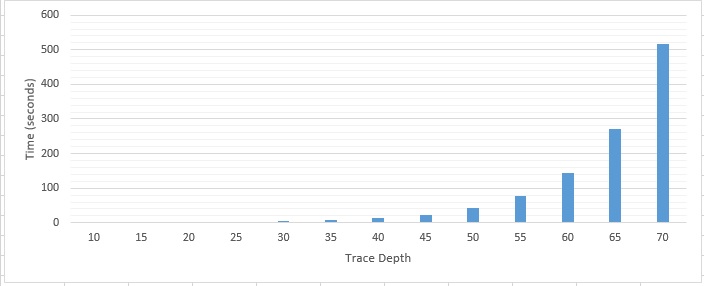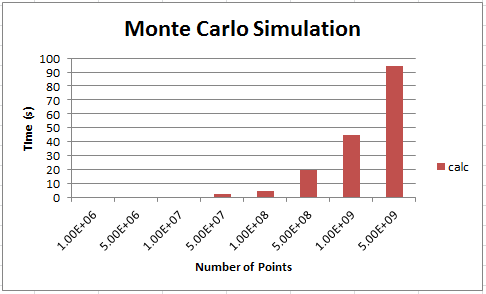Skynet/GPU610
GPU610/DPS915 | Student List | Group and Project Index | Student Resources | Glossary
Team Pages: GPU610 | GAM531
Contents
Selected Program
Ray Tracer
Team Members
Progress
Assignment 1
Bruno
For assignment 1 I looked into finding a simple Ray Tracer that could be easily understood by someone with no image processing background and benefit from parallelization.
I found ray tracer that matched the criteria I was looking for at http://scratchapixel.com/assets/Uploads/Lesson001/Source%20Code/raytracer.cpp
Looking into Big O notation I believe this program falls under [f(n) = n ^ 2]
I profiled the ray tracer by modifying trace depths, as seen below:
Depth of 70
Each sample counts as 0.01 seconds.
% cumulative self self total time seconds seconds calls ms/call ms/call name 99.99 517.97 517.97 307200 1.69 1.69 Vec3<float> trace<float>(Vec3<float> const&, Vec3<float> const&, std::vector<Sphere<float>*, std::allocator<Sphere<float>*> > const&, int const&) 0.01 518.00 0.03 void render<float>(std::vector<Sphere<float>*, std::allocator<Sphere<float>*> > const&) 0.00 518.00 0.00 1 0.00 0.00 _GLOBAL__sub_I_main
The program spends nearly 100% of all processing with in its Vec3 trace method, this is a recursive method.
Vec3<T> trace(const Vec3<T> &rayorig, const Vec3<T> &raydir,const std::vector<Sphere<T> *> &spheres, const int &depth)
.......
.......
if ((sphere->transparency > 0 || sphere->reflection > 0) && depth < MAX_RAY_DEPTH) {
T facingratio = -raydir.dot(nhit);
// change the mix value to tweak the effect
T fresneleffect = mix<T>(pow(1 - facingratio, 3), 1, 0.1);
Vec3<T> refldir = raydir - nhit * 2 * raydir.dot(nhit);
refldir.normalize();
Vec3<T> reflection = trace(phit + nhit * bias, refldir, spheres, depth + 1);
Vec3<T> refraction = 0;
if (sphere->transparency) {
T ior = 1.1, eta = (inside) ? ior : 1 / ior;
T cosi = -nhit.dot(raydir);
T k = 1 - eta * eta * (1 - cosi * cosi);
Vec3<T> refrdir = raydir * eta + nhit * (eta * cosi - sqrt(k));
refrdir.normalize();
refraction = trace(phit - nhit * bias, refrdir, spheres, depth + 1);
}
surfaceColor = (reflection * fresneleffect + refraction * (1 - fresneleffect) * sphere->transparency) * sphere->surfaceColor;
}
...
...
void render(const std::vector<Sphere<T> *> &spheres)
{
unsigned width = 640, height = 480;
Vec3<T> *image = new Vec3<T>[width * height], *pixel = image;
T invWidth = 1 / T(width), invHeight = 1 / T(height);
T fov = 30, aspectratio = width / T(height);
T angle = tan(M_PI * 0.5 * fov / T(180));
// Trace rays
for (unsigned y = 0; y < height; ++y) {
for (unsigned x = 0; x < width; ++x, ++pixel) {
T xx = (2 * ((x + 0.5) * invWidth) - 1) * angle * aspectratio;
T yy = (1 - 2 * ((y + 0.5) * invHeight)) * angle;
Vec3<T> raydir(xx, yy, -1);
raydir.normalize();
*pixel = trace(Vec3<T>(0), raydir, spheres, 0);
}
}
Michael
I have picked the Monte Carlo simulation for this assignment. Source code was from here and was modified to take and argument as the number of iterations and factored out the function which is going to be used for parallelzation.
Runtime for this program O(N) and the results are as follows:
| N Iterations | Time (seconds) |
|---|---|
| 1,000,000 | 0.02 |
| 5,000,000 | 0.24 |
| 10,000,000 | 0.42 |
| 50,000,000 | 2.22 |
| 100,000,000 | 4.75 |
| 500,000,000 | 19.97 |
| 1,000,000,000 | 44.5 |
| 5,000,000,000 | 94.08 |
Due to the simplicity of the program, all of the time spent was on the calc function below, as iterations increased, the time it takes increases at a linear rate.
Function to parallelize:
void calc(int iterations, int* count){
double x, y, z;
for (int i=0;i<iterations;i++){
x = (double)rand()/RAND_MAX;
y = (double)rand()/RAND_MAX;
z = x*x+y*y;
if (z<=1){
(*count)++;
}
}
}
Assignment 3
What is a Ray Tracer?
A program that performs ray tracing, which is a technique for creating images by tracing light paths (rays) through all the pixels in the image and simulating the effects light would have based on the objects the light (rays) encounters.
We decided this would be a problem that could benefit greatly from parallel processing, and it has, by over 350 times speed up.
Optimizations Used
__device__ __host__ : we used this so that parts of classes Vec3 and Sphere could be accessed by both the host and device were necessary.
class Vec3
{
public:
float x, y, z;
__device__ __host__ Vec3() : x(float(0)), y(float(0)), z(float(0)) {}
__device__ __host__ Vec3(float xx) : x(xx), y(xx), z(xx) {}
__device__ __host__ Vec3(float xx, float yy, float zz) : x(xx), y(yy), z(zz) {}
__device__ __host__ Vec3& normalize()
{
...__device__ __forceinline__ : because the program uses various loops and recursion we force the compiler to use inline functions to speed up the trace and mix functions as well as some methods in the Vec3 and Sphere class.
__device__ __forceinline__ Vec3 trace(const Vec3 &rayorig, const Vec3 &raydir, const Sphere* spheres, const int depth, int nsphere)
{
...sqrtf, tanf, fmaxf : where std:: was being used we replaced it with CUDA's math library equivalents although gains were marginal from this.
}
surfaceColor += sphere->surfaceColor * transmission * fmaxf(float(0), nhit.dot(lightDirection)) * spheres[i].emissionColor;
}shared memory : we implemented shared memory but quickly realized that it was actually slower then sticking to global memory, we believe this has to do with the number of times the array has to be copied into shared memory.
//extern __shared__ char test[];
/*Sphere* sp = (Sphere*)&test[0];
for(int i = 0; i < nsphere; i++)
{
sp[i] = spheres[i];
}*/- We also needed to rework a few parts of code in order to be parallelized
Difficulties
RECURSION: this was the original difficulty that forced us to use a ray tracer that took into account no transparency/reflection/depth in assignment 2. For assignment 3 we decided we wanted a relatively full featured ray tracer and decided to work on recursion. Recursion itself is support on gpu's with compute capability of 2.0+, but we ran into stack memory issues, because of recursion the compiler was not able to identify the stack size required for our kernel and in effect was allocating less memory then we required. Eventually we realized we could manually re-size the stack by using cudaThreadSetLimit(cudaLimitStackSize,..);, after testing various combination we came up with a sizing scheme that made everything work.
What We Learnt
First off taking someone else's code on a subject we know nothing about was a definite learning experience in itself, through breaking down code segments and working through the various mathematics involved we now have a decent grasp on how ray tracing works as a technique. Once we got past this hurdle we quickly figured out that everything we learnt in class revolved around matrix optimizations for the most part and those were not present in our problem, so we had to do a lot of side reading. After all was said and done we tried to implement constant and shared memory but with either no success or poor results, switching our focus instead to the repetitive nature of our program and change our main function to an inline function and moving all the required code strictly onto the device. At the end of the day we have a much better, but far from "in depth" understanding of some of CUDA's features and capabilities.
What Would We Do Differently?
We would look for a program that used matrices and related math in order to more directly apply our in class lectures to our assignment.


